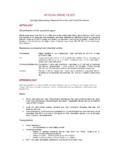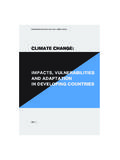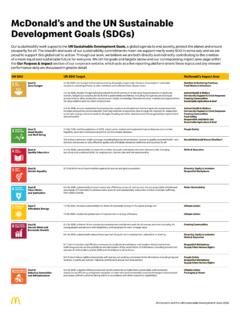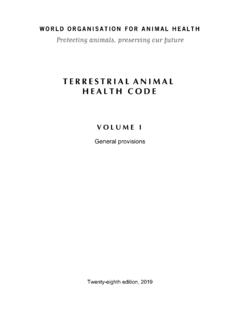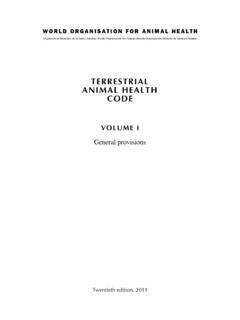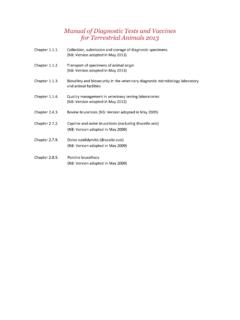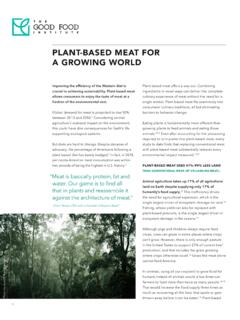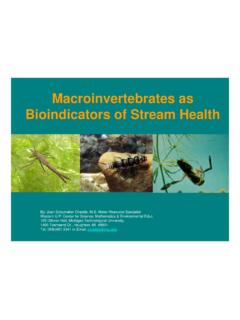Transcription of Draft Guidance Document on Terrestrial Ecotoxicology
1 1 EUROPEAN COMMISSIONHEALTH & CONSUMER PROTECTION DIRECTORATE-GENERAL Directorate E - Food Safety: plant health , animal health and welfare,international questionsE1 - Plant healthSANCO/10329/2002 rev 2 final17 October 2002 DRAFTW orking DocumentGuidance Documenton Terrestrial EcotoxicologyUnder Council Directive 91/414/EECThis Document has been conceived as a working Document of the Commission Serviceswhich was elaborated in co-operation with the Member States. It does not intend toproduce legally binding effects and by its nature does not prejudice any measure takenby a Member State within the implementation prerogatives under Annex II, III and VI ofCommission Directive 91/414/EEC, nor any case law developed with regard to thisprovision. This Document also does not preclude the possibility that the European Courtof Justice may give one or another provision direct effect in Member 32 General issues.
2 Introduction to the assessment of chemicals in the Terrestrial environment .. animal experimentation .. NOEC-values as summary parameters .. Test substance, formulation Endocrine Higher tier tests .. Persistence .. Risk assessment .. 83 Terrestrial vertebrates .. Data requirements and Exposure Risk assessment .. Risk mitigation options .. Data requirements and Exposure Risk assessment .. Risk mitigation options .. 195 Other arthropods .. Data requirements and Exposure Risk assessment .. Risk mitigation options .. 246 Soil Data requirements and Exposure Risk assessment .. Risk management options .. 317 Non-target Data requirements and Exposure Risk assessment .. Risk mitigation options .. 358 Other non-target 359 Terms and abbreviations .. 3731 IntroductionArticle 5 of the Directive provides that in the light of current scientific and technicalknowledge, an active substance shall be included in Annex I for an initial period notexceeding 10 years, if it may be expected that plant protection products containing the activesubstance.
3 Do not have any unacceptable influence on the environment ..Annexes II and III of Directive 91/414/EEC set out the data requirements for the inclusion ofan active substance into Annex I of the Directive and for the authorisation of a plantprotection product at Member State level. Annex VI of the Directive includes the decisionmaking criteria for the authorisation of plant protection products at Member State level. It is the purpose of this Document to provide Guidance to Rapporteurs, peer reviewing MemberStates, Notifiers and Applicants on the use and interpretation of the Terrestrial ecotoxicologysections of Annexes II and III and to lay down agreed procedures and criteria for decisionmaking. The general aim is to promote consistency and transparency in decision making andto describe agreed risk assessment procedures for the assessment of plant protection productsin the context of the inclusion of their active substances in Annex I to Directive 91/414/EEC.
4 It has to be recognised that the authorisation of plant protection products after Annex Iinclusion of active substances remains the responsibility of Member States. Risk managementand risk mitigation measures described in this Document do not pre-empt this authority of theMember States and are meant as a non-exhaustive list of agreed options, which can be takeninto consideration on the Community level for decision making concerning Annex I inclusion. The Ecotoxicology data requirements for active substances and plant protection products areset out in Annex II, section 8 and Annex III section 10 of Directive 91/414/EC, respectively. Itshould be noted that the introduction to these sections provides useful information on thepurpose and use of data submitted. It is clearly stated that the data submitted must besufficient to permit a scientifically valid assessment of the impact on non-target species.
5 Inorder to fulfil this objective, tests additional to those outlined in Annex II and III may beneeded in individual cases if there is a specific and techniques in ecotoxicological risk assessment progress rapidly and it is noted thatit is difficult for both notifiers or applicants as well as reviewers to take such progress fullyinto account in their dossiers and assessment reports during ongoing reviews. To provide areliable framework for the review process and to avoid undue delays, the current version ofthis Guidance Document should therefore only be used for the review of existing activesubstances notified in the third phase of the review programme according to Regulation451/20001 and subsequent phases. For new active substances the Document should beimplemented for dossiers submitted from 1 August 2003. However, some flexibility may stillbe necessary during a transitional period of 2-3 years.
6 Decision making should take intoconsideration that certain higher tier data requirements ( litter bag studies) which aretriggered now, may not have been obvious to applicants or notifiers at the time of theirnotification or dossier submission. Likewise, if this appears justified in individual cases and 1 OJ L 55, , decision making, the updated Guidance may be considered also for substances inearlier phases of the review Document is to be revised regularly, in order to reflect changes of test guidelines and ofscientific General Introduction to the assessment of chemicals in the terrestrialenvironmentThe assessment of the effects and risks of chemicals for the Terrestrial environment is acomplex matter. This complexity comes, among others, from factors such as the need forsharing of the available landscape among urban/industrial activities, agricultural production inthe form of agro-systems, and supporting Terrestrial ecosystems.
7 In addition, terrestrialsystems are not associated with a single compartment, but with the interface between soil andthe atmosphere. Although purely soil-dwelling organisms play a clear role, basic ecosystemfunctioning and biodiversity is associated with organisms, such as Terrestrial plants, manyinvertebrates, and certain Terrestrial vertebrates that are simultaneously or sequentially locatedin the soil or above-soil risk assessment for Terrestrial ecosystems has been reviewed by the Scientific Committeeon Toxicology, Ecotoxicology and the Environment (CSTEE 2000). According to thisdocument: General adverse effects on the Terrestrial environment include: Effects on soil functions, and particularly on the capacity of soil to act as substrate forplants including effects on seed germination, and those on organisms (invertebrates,micro-organisms) important for proper soil function and nutrient cycle conservation.
8 Effects on plant biomass production, related to contamination of soil or air includingdeposition on plant surfaces. Plants are the source of food for the whole system(including humans) and have additional roles in terms of land protection, nutrientcycles, equilibrium of gases in the atmosphere, etc. Effects on soil, above-ground and foliar invertebrates, which represent food for otherorganisms, and cover essential roles as pollinators, detrivores, saprophages, pestcontroller, etc. Effects on Terrestrial vertebrates exposed to contaminated food, soil, air, water orsurfaces, with obvious economic and/or social consequences. Poisoned birds andmammals probably constitute the highest social concern, while reproductive effects,although less evident, represent a higher ecological hazard. Accumulation of toxic compounds in food items and through the food chain. Is atypical exposure route for animals within the contaminated ecosystem and representsan additional concern related to the consumption of this food by humans and concerns combine human and ecological interests.
9 Direct human interests includemanaged species (cultivated plants and trees, bees, domestic animals) but also wild speciesessential as source for supplies ( forest, pasture), landscape conservation ( cover), or even for leisure (from gaming to bird-watching). From an ecologicalpoint of view, any of these effects will provoke a dramatic alteration of the structure and5functioning of the ecosystem which are considered the basic protection goals in ecologicalrisk assessment. However, as frequently noted by the Scientific Committee on Plants, the environmental riskassessment of plant protection products requires some adjustment of the generic ecologicalrisk assessment framework as effects on living organisms considered as pests can be bothacceptable and desirable. Directive 91/414/EC includes the need for specific assessments on certain Terrestrial non-target groups, such as Terrestrial vertebrates, bees, other non-target arthropods, earthworms orsoil micro-organisms, as well as additional generic assessments such as on soil macro- andmesofauna when triggered by fate properties (persistence).
10 Targeted risk assessment, using a combination of key ecological receptors and relevantexposure routes has been recently suggested as an efficient way of solving the complexity ofthe Terrestrial environment risk assessment (Tarazona et al. 2002). This possibility fitsperfectly with a protection aim established for plant protection products, allowing theidentification of target species and non-target ecological is a common understanding that the ecological risk assessment aims not at individualsbut at the protection of populations. In general the continuance of populations of non-targetorganisms should be ensured. Structural and functional endpoints should be regarded of animal experimentationFor reasons of animal welfare all efforts should be made to avoid unnecessary tests especiallyon vertebrate NOEC-values as summary parametersIn several tests the aim is to determine the no-observed-effect concentration (NOEC), aconcept that has been challenged on scientific grounds (Laskowski 1995, OECD 1998).










